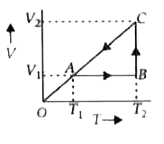One mole of an ideal gas expand spontaneously into a vacccum. The work done is
2J
4 J
zero
infinity
The correct Answer is:C
To solve the problem of finding the work done when one mole of an ideal gas expands spontaneously into a vacuum, we can follow these steps:
1. Understanding the Scenario:
- We have one mole of an ideal gas that is expanding into a vacuum. In this case, there is no opposing pressure acting on the gas.
2. Work Done Formula:
- The work done (W) by a gas during expansion or compression is given by the formula:
W=−PexternalΔV
where Pexternal is the external pressure and ΔV is the change in volume.
3. Identifying External Pressure:
- Since the gas is expanding into a vacuum, the external pressure (Pexternal) is 0 atm (or 0 Pa).
4. Calculating Work Done:
- Substituting the values into the work done formula:
W=−(0)ΔV=0
- Therefore, the work done by the gas during this expansion is 0.
5. Conclusion:
- The work done when one mole of an ideal gas expands spontaneously into a vacuum is:
W=0
Final Answer:
The work done is 0.
- We have one mole of an ideal gas that is expanding into a vacuum. In this case, there is no opposing pressure acting on the gas.
- The work done (W) by a gas during expansion or compression is given by the formula:
W=−PexternalΔV
where Pexternal is the external pressure and ΔV is the change in volume.
- Since the gas is expanding into a vacuum, the external pressure (Pexternal) is 0 atm (or 0 Pa).
- Substituting the values into the work done formula:
W=−(0)ΔV=0
- Therefore, the work done by the gas during this expansion is 0.
- The work done when one mole of an ideal gas expands spontaneously into a vacuum is:
W=0
The work done is 0.
Topper's Solved these Questions
- THERMODYNAMICS AND THERMOCHEMISTRY BOOK - FIITJEECHAPTER - THERMODYNAMICS AND THERMOCHEMISTRY EXERCISE - ASSIGNMENT PROBLEMS (OBJECTIVE) LEVEL-I (REASONING TYPE QUESTIONS)
2 Videos
- THERMODYNAMICS AND THERMOCHEMISTRY BOOK - FIITJEECHAPTER - THERMODYNAMICS AND THERMOCHEMISTRY EXERCISE - ASSIGNMENT PROBLEMS (OBJECTIVE) LEVEL-II
25 Videos
- THERMODYNAMICS AND THERMOCHEMISTRY BOOK - FIITJEECHAPTER - THERMODYNAMICS AND THERMOCHEMISTRY EXERCISE - ASSIGNMENT PROBLEMS (SUBJECTIVE) LEVEL -2
15 Videos
- TEST PAPERSBOOK - FIITJEECHAPTER - TEST PAPERSEXERCISE - CHEMISTRY
747 Videos
- TRANSITION ELEMENTS & COORDINATION COMPOUNDSBOOK - FIITJEECHAPTER - TRANSITION ELEMENTS & COORDINATION COMPOUNDSEXERCISE - MATCHIG LIST TYPE QUESTIONS
1 Videos
Similar Questions
Knowledge Check
Two moles of an ideal gas expand spontaneouly into vacuum. The work done is :-
AZeroB2JC4JD8JTwo moles of an ideal gas expand spontaneouly into vacuum. The work done is :-
A2 JouleB4 JouleCZeroDInfiniteTwo moles of an ideal gas expand spontaneouly into vacuum. The work done is :-
AZeroB2 JC4 JD8 J
1 moles of an ideal gas expanded spontaneously into vaccum. The work done will be
View SolutionThree moles of an ideal gas expanded spotaneously into vacuum. The work done will be
View SolutionTwo method of an ideal gas expand spontaneously in vacuum. The work done is:
View SolutionThree moles of an ideal gas expanded sponteneously in to vaccum. Then which is correct ?
View SolutionA cyclic process for 1 mole of an ideal gas is shown in the V-T diagram. The work done in AB, BC and CA respectively are

View Solution
